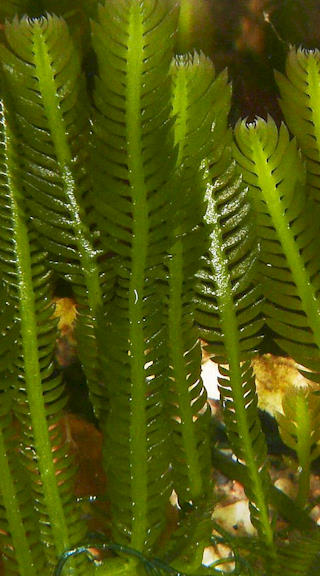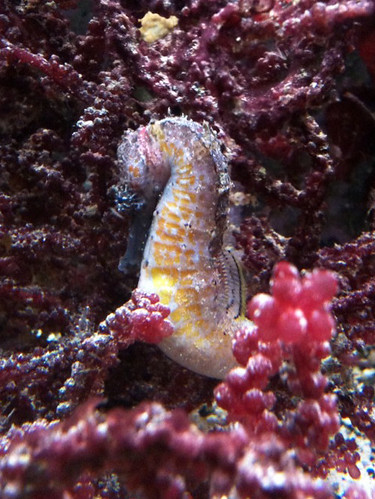|
The
term marine plant is used as a general term to describe both macro algae and sea grass. Macro algae,
unlike sea grass are not true plants but are actually large celled
algae. They absorb nutrients through their cell structure instead
of the
root system as terrestrial plants do. All macro algae are
photosynthetic and thus rely on the sun's energy for food. Marine
plants serve as the
base of our ocean's food chain, providing food, oxygen and habitat
for thousands of marine inhabitants. Unlike marine plants (sea grass), macro algae lack conductive tissue, true roots, stems
and flowers. Instead of roots they have holdfasts or rhizomes in
which individual runners support the growth between blades or
stalks depending on the species.
 Marine
plants grown in the aquarium will thrive under the
right conditions and offer a replenishing food source to tank
inhabitants.
In addition to
sunlight they also
require nutrients to grow. It's generally accepted that all
species of marine plants
require the same essential nutrients as both aquatic and terrestrial
plants do. The major nutrients required by marine plants are
nitrogen, phosphorus, potassium, sulfur, calcium & magnesium.
The minor nutrients are iron, manganese, copper, zinc &
molybdenum. Marine
plants grown in the aquarium will thrive under the
right conditions and offer a replenishing food source to tank
inhabitants.
In addition to
sunlight they also
require nutrients to grow. It's generally accepted that all
species of marine plants
require the same essential nutrients as both aquatic and terrestrial
plants do. The major nutrients required by marine plants are
nitrogen, phosphorus, potassium, sulfur, calcium & magnesium.
The minor nutrients are iron, manganese, copper, zinc &
molybdenum.
Marine
plants are distributed worldwide and are found in some form in
almost every ocean on the Earth. There are two distinct habitats
where macro algae are found, temperate or cold water algae, and
tropical varieties. The tropical and sub tropical species are of
most interest to hobbyists to culture, as the cold water species
have special needs requiring a climate controlled environment
(chiller). Throughout the world, marine algae grow at varying
depths and environments so some are more suitable for culture in the aquarium than others. Several species can even be
successfully kept with lower light as they are found and collected
from deep water habitats, while others need a brightly illuminated
habitat to thrive. There's been much debate among marine aquarists over which individual
species are best suited for culture in a refugium or display tank
and which should be avoided all together. Some species are fast
growing, invasive and can be a nuisance in any aquarium,
especially reef tanks. Despite
their sometimes invasive reputation, they're many beautiful species of macro
algae that are fairly easy to keep in a marine aquarium. For the
aquarist interested in the culture of macro algae there are hundreds
to choose from, but only a handful of species that are available to
the hobbyist. It's these specific species that will be covered
in detail.
 The three main classifications
of marine macro algae are Chlorophyta (green algae), Phaeophyta
(brown algae), and Rhodophyta (red algae). They derive their names
from the dominant pigments associated with each species. All of
these classes also contain slightly calcified or heavily calcified
algae, which depend upon properly maintained calcium levels to grow and reproduce.
Sea grasses have their own classification (Magnoliophytae or Angiospermae) and will be covered separately. Mangrove plants
are also discussed, as they are often used by hobbyists in the marine
aquarium. Although their growth is slow and overall nutrient uptake
limited, they remain popular additions, especially in a refugium. The three main classifications
of marine macro algae are Chlorophyta (green algae), Phaeophyta
(brown algae), and Rhodophyta (red algae). They derive their names
from the dominant pigments associated with each species. All of
these classes also contain slightly calcified or heavily calcified
algae, which depend upon properly maintained calcium levels to grow and reproduce.
Sea grasses have their own classification (Magnoliophytae or Angiospermae) and will be covered separately. Mangrove plants
are also discussed, as they are often used by hobbyists in the marine
aquarium. Although their growth is slow and overall nutrient uptake
limited, they remain popular additions, especially in a refugium.
Beginning
around 1980 a strain of Caulerpa known as C.
taxifolia was used as a tank decoration in several
marine aquariums in Germany
and was then successfully propagated and distributed for use in
commercial
aquariums across the globe. This extremely hardy and
more temperature tolerant strain was soon discovered to have
escaped into the waters of the Mediterranean and was found growing
in large patches near shore. This
highly invasive species has
since
been discovered worldwide, most notably off the coast of
California, USA
and
New South Wales,
Australia. The introduction of the hybrid C. taxifolia has been
largely blamed on the
ornamental aquarium industry. It was supposedly released only feet
from the famous
Monaco
Aquarium where it was being used as tank decorations. Because of its invasive qualities and toxicity to herbivorous
fish, C. taxifolia and 8 other species were banned for sale
or distribution in several
U.S. states as well as many countries. As of today the
state of California has banned all Caulerpa species from import.
|

 The three main classifications
of marine macro algae are Chlorophyta (green algae), Phaeophyta
(brown algae), and Rhodophyta (red algae). They derive their names
from the dominant pigments associated with each species. All of
these classes also contain slightly calcified or heavily calcified
algae, which depend upon properly maintained calcium levels to grow and reproduce.
Sea grasses have their own classification (Magnoliophytae or Angiospermae) and will be covered separately. Mangrove plants
are also discussed, as they are often used by hobbyists in the marine
aquarium. Although their growth is slow and overall nutrient uptake
limited, they remain popular additions, especially in a refugium.
The three main classifications
of marine macro algae are Chlorophyta (green algae), Phaeophyta
(brown algae), and Rhodophyta (red algae). They derive their names
from the dominant pigments associated with each species. All of
these classes also contain slightly calcified or heavily calcified
algae, which depend upon properly maintained calcium levels to grow and reproduce.
Sea grasses have their own classification (Magnoliophytae or Angiospermae) and will be covered separately. Mangrove plants
are also discussed, as they are often used by hobbyists in the marine
aquarium. Although their growth is slow and overall nutrient uptake
limited, they remain popular additions, especially in a refugium.